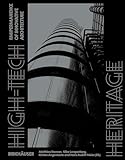High-Tech Heritage : (Im)permanence of Innovative Architecture / ed. by Matthias Brenner, Silke Langenberg, Kirsten Angermann, Hans-Rudolf Meier.
Material type: TextPublisher: Basel : Birkhäuser, [2024]Copyright date: 2025Description: 1 online resource (256 p.)Content type:
TextPublisher: Basel : Birkhäuser, [2024]Copyright date: 2025Description: 1 online resource (256 p.)Content type: - 9783035629606
- 9783035629620
- Bauen im Bestand
- Baukultur
- Denkmalpflege
- Erhaltung
- High-Tech Architektur
- Umnutzung
- Hans-Rudolf Meier
- Kirsten Angermann
- Matthias Brenner
- Silke Langenberg
- architectural monument
- building culture
- conversion
- cultural heritage
- high-tech architecture
- historical monument
- maintenance
- monument preservation
- postmodern architecture
- postmodernism
- preservation
- online - DeGruyter
- Issued also in print.
| Item type | Current library | Call number | URL | Status | Notes | Barcode | |
|---|---|---|---|---|---|---|---|
 eBook
eBook
|
Biblioteca "Angelicum" Pont. Univ. S.Tommaso d'Aquino Nuvola online | online - DeGruyter (Browse shelf(Opens below)) | Online access | Not for loan (Accesso limitato) | Accesso per gli utenti autorizzati / Access for authorized users | (dgr)9783035629620 |
Frontmatter -- Table of Contents -- (Im)Permanence of Innovation -- High-Tech Heritage: (Im)Permanence of Innovation -- In Conversation with Silke Langenberg and Matthias Brenner -- HISTORY OF HIGH-TECH IN ARCHITECTURE AND DESIGN -- Pictures -- High-Tech in the Context of Czech Late Socialism? -- Around the Structures -- Eco-Pomo between High-Tech and Low-Tech: Three Experimental Houses -- Collecting High-Tech: Notes on the Theo Hotz Bequest at the gta Archives -- In Conversation with Silke Langenberg -- THEORETICAL AND PRACTICAL CHALLENGES OF HIGH-TECH HERITAGE -- Pictures -- Heritage and Cutting-Edge Technology: Learning from Buildings as Machines -- Innovation Ad Infinitum: Lloyd’s of London and the Cost of Flexibility -- The University Hospital of the RWTH Aachen University: Structure and Dynamic -- Sports Architecture: High-Tech Urban Infrastructure between Identity, Enhancement, and Redevelopment -- High-Tech Roots: The London Zoo Aviary and Its Preservation -- Structural Sealant Glazing (SSG): History, Construction, and Conservation Challenges -- Saving Reused Building Materials through Architectural Design: The Case of the Centre Pompidou Glass -- High-Tech Bavaria: Late Modern Architecture in the Rear-View Mirror -- High-Tech Additions: Italian Research in Preserving and Reusing Built Heritage -- Surface and Flesh: Facade as a Conservation Tool -- In Conversation with Silke Langenberg -- INVENTORY AND MEDIATION -- Pictures -- The Unbearable Outdatedness of Registers -- Specifics of Buildings Featuring Machinism and High-Tech Aesthetics in Bohemia: Case Study of Harrachov Ski Jumps and Their Possible Reuse -- Baukultur 1975–2000: Giving a Voice to Younger Architectural Monuments -- Virág Csaba and Hungary’s Disappearing Plasticist High-Tech Architecture -- CASE STUDIES AND CURRENT RESEARCH -- Pictures -- The [High-Tech] Plumber of Architecture: John Winter through the Nancy Seear Building -- The Máj Department Store in Prague as Heritage: The Impermanence of Conservation? -- Takis Zenetos and High-Tech Architecture: Electronic Urbanism vis-à-vis Autonomous Ecological Living Units -- POSTERS -- School Building in Uttwil (CH): Heritage Value Investigation Based on Architectural Detail -- High-Tech in Reverse -- The Unitobler Bern: Energy Potential of the Existing Fabric -- Shifting Paradigms and High-Tech: Revisiting the University of Salford Centenary Building with Sustainability in Mind -- Reverse Engineering of Planar Sheet Metal Facade of the Briefzentrum Mülligen -- Heterotopias of High-Tech Architectural Heritage: Three Conceptual Scaffoldings -- School at Kinkplatz: Contemporary Monument Preservation for High-Tech Architecture -- Authors -- Image Credits -- Imprint
restricted access online access with authorization star
http://purl.org/coar/access_right/c_16ec
High-Tech Architektur - Innovatives Konstruktionserbe erhaltenDie High-Tech Architektur der 1970er–1990er Jahre zeichnet sich durch den Einsatz und die Zurschaustellung fortschrittlicher Technologien aus. Das Erscheinungsbild der Gebäude ist geprägt von innovativen Fassaden, farblich betonten Tragkonstruktionen und expressiv zur Schau gestellten Haustechniksystemen. Bedauerlicherweise führt das rasche Veraltern technischer Innovationen jedoch häufig zum vollständigen Ersatz der die Architektur wesentlich bestimmenden Systeme.Eine internationale Tagung an der ETH Zürich in Zusammenarbeit mit der Bauhaus-Universität Weimar ist 2023 der Frage nach einem adäquaten Umgang mit dem Konstruktionserbe technologisch innovativer Architektur nachgegangen. Dieses Buch fasst deren Ergebnisse zusammen und bietet einen Überblick über den aktuellen Stand der Forschung. Aktueller Stand der Wissenschaft zu High-Tech Architektur und Denkmalschutz Überblick über Chancen und Herausforderungen von High-Tech-Konstruktionen Neue Erkenntnisse zum Thema Bauen im Bestand Auch als Set mit dem Kongressband Denkmal Postmoderne 978-3-0356-2783-1 erhältlich
High-tech Architecture - Preserving the Heritage of Innovative Construction The high-tech architecture of the 1970s–1990s is typically characterized by the use and exhibition of advanced technologies. In terms of appearance, these buildings often have innovative façades, supporting structures accentuated in color, and expressively displayed technology systems. Unfortunately, however, the rapid obsolescence of technology has often led to the complete replacement of the very systems that defined the architectural form. In 2023, an international conference at ETH Zurich in collaboration with Bauhaus-Universität Weimar explored the question of how best to deal with the structural legacy of technologically innovative architecture. This book summarizes the results and provides an overview of the current state of research. Current state of research on high-tech architecture and its conservation Overview of the opportunities and challenges of high-tech buildings New findings on the topic of building within existing structures Also available as a set with the congress volume Denkmal Postmoderne 978-3-0356-2783-1
Issued also in print.
Mode of access: Internet via World Wide Web.
In English.
Description based on online resource; title from PDF title page (publisher's Web site, viewed 20. Nov 2024)


